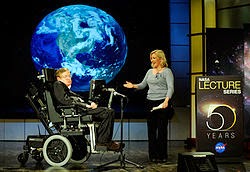|
Born
|
Stephen William Hawking
|
8 January 1942 (age 72)
| |
Oxford, England
| |
Residence
|
United Kingdom
|
Fields
|
General relativity
|
Quantum gravity
| |
Notable awards
|
Adams Prize (1966)
|
FRS (1974)
| |
Eddington Medal (1975)
| |
Maxwell Medal and Prize (1976)
| |
Heine man Prize (1976)
| |
Hughes Medal (1976)
| |
Albert Einstein Award (1978)
| |
CBE (1982)
| |
RAS Gold Medal (1985)
| |
Dirac Medal (1987)
| |
Wolf Prize (1988)
| |
CH (1989)
| |
Prince of Asturias Award (1989)
| |
Andrew Gemant Award (1998)
| |
Naylor Prize and Lectureship (1999)
| |
Lilienfeld Prize (1999)
| |
Albert Medal (Royal Society of Arts) (1999)
| |
Copley Medal (2006)
| |
Presidential Medal of Freedom (2009)
| |
Fundamental Physics Prize (2012)
|
An English theoretical physicist, cosmologist,
author and Director of Research at the Centre for Theoretical Cosmology within the University of Cambridge. Among his
significant scientific works have been a collaboration with Roger Penrose on gravitational singularity theorems in the framework of general relativity, and the theoretical
prediction that black holes emit radiation, often called Hawking
radiation. Hawking was the first to set forth a cosmology explained by a union of the general theory of relativity and quantum
mechanics. He is a vocal supporter of the many-worlds interpretation of quantum mechanics.
Hawking is an Honorary
Fellow of the Royal Society
of Arts, a lifetime member of the Pontifical Academy of Sciences,
and a recipient of the Presidential Medal of Freedom, the highest
civilian award in the United States. Hawking was theLucasian Professor of Mathematics at the University of Cambridge between
1979 and 2009.
Hawking has achieved success with works of popular
science in which he
discusses his own theories and cosmology in general; his A Brief History of Time stayed on the British Sunday Times best-sellers list for a
record-breaking 237 weeks.
Hawking has a motor neuron disease related to amyotrophic lateral sclerosis (ALS), a condition that has progressed
over the years. He is almost entirely paralysed and communicates through a speech-generating device. He married twice
and has three children.
Hawking taking a zero-gravity flight in a "Vomit Comet"
1970 Singularities in gravitational collapse
Physicists working on Einstein's theory of gravity noticed that it
allowed for singularities – points where spacetime appeared to be infinitely
curved. But it was unclear whether singularities were real or not. Roger
Penrose at Birkbeck College in London proved that singularities would indeed
form in black holes. Later, Penrose and Hawking applied the same
idea to the whole universe and showed that Einstein's theory predicted a
singularity in our distant past. It was the big bang.
1971-72 Black
hole mechanics
Black
holes have their own set of laws that mirror the more familiar laws of
thermodynamics. Hawking came up with the second law, which states that the
total surface area of a black hole will never get smaller, at least so far as
classical (as opposed to quantum) physics is concerned. Also known as
the Hawking area theorem, it created a puzzle for physicists. The law implied
that black holes were hot, a contradiction of classical physics that said
black holes could not radiate heat. In separate work, Hawking worked on the
"no hair" theorem of black holes, which states that black holes
can be characterized by three numbers – their mass, angular momentum
and charge. The hair in question is other information that vanishes when
it falls into the black hole.
1974-75 How
black holes can vanish
Nothing can escape a black hole, or so physicists once thought.
Hawking drew on quantum theory to show that black holes should emit
heat and eventually vanish. The process is slow for normal black holes. It
would take longer than the age of the universe for a black hole with the same
mass as our sun to evaporate. But smaller black holes evaporate faster, and
near the end of their lives release heat at a spectacular rate. In the last
tenth of a second, a black hole could explode with the energy of a million one
megaton hydrogen bombs.
Stephen Hawking being presented by his daughter Lucy Hawking at the lecture he gave for NASA's 50th anniversary
1982 How galaxies might arise
A popular theory in cosmology
holds that the fledgling universe went through a period of rapid inflation soon
after the big bang. Hawking was one of the first to
show how quantum fluctuations – minuscule variations in the distribution of
matter – during inflation might give rise to the spread of galaxies in the
universe. What started as a tiny difference grew into the cosmic structure we
see, as gravity made matter clump together. Recent maps of the heavens that
pick up the faint afterglow of the big bang reveal the kinds of variations
Hawking worked with.
1983 Wave function of the
universe
Hawking has spent much of his
time trying to develop a quantum theory of gravity. He started out applying his
idea of Euclidean quantum gravity to black holes, but in 1983 teamed up with
Jim Hartle at Chicago University. Together they proposed a "wave function of the universe"
that, in theory, could be used to calculate the properties of the universe we
see around us.
Videos
Books
.......................created
by Gitanjalee Bhuse-Ghodake



No comments:
Post a Comment